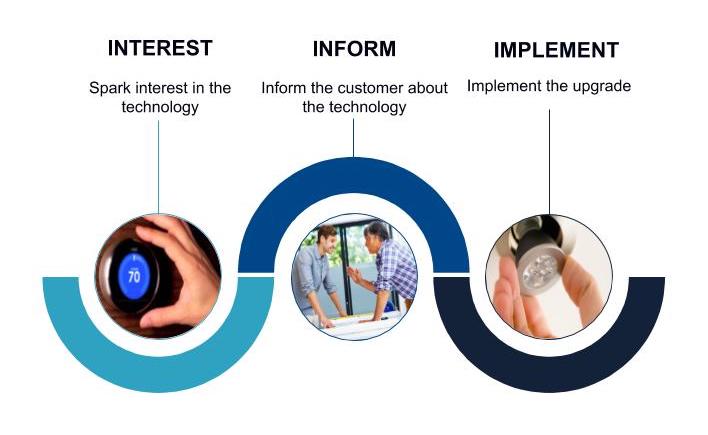
The Consumer Connection: A Consumer-Centric Approach to Delivering Home Energy Services
Two-thirds of US homeowners consider home energy performance a top priority, but few actually take action to improve home energy use. And those who have implemented efficiency improvements seldom invest in whole-home energy upgrades. In sum, a large gap exists between intentions and actual investments, signifying a market failure to address customer needs. Rocky Mountain Institute set out to understand why the market is failing to convert more homeowner interest in energy efficiency into action despite increased spending and efforts to do so.
RMI’s recent report, The Consumer Connection: A Consumer-Centric Approach to Delivering Home Energy Services, describes the consumer-centered approach that is needed to unlock the market for energy upgrades. Through a survey conducted with 1,210 homeowners from all 50 US states, RMI’s Residential Energy+ team learned how service providers—including contractors, energy auditors, program administrators, and utilities—can be more strategic. Specifically, the team learned what types of messengers, financing, and timing make most sense to consumers and do the most to spur adoption of residential energy efficiency upgrades. In addition, the survey revealed other important findings around financing, what customers are willing to pay, and what the main motivations are for energy upgrades.
The Triggers and the Messengers
We know that certain triggers—such as a new home purchase, a renovation done in order to sell a home, or broken equipment—spur the implementation of home energy upgrades. These triggers are object lessons in the importance of selling a product to people when they want it, not when the provider wants to sell it. The survey helped us understand how the different triggers should inform marketing efforts. The survey focused on six triggers:
- Purchasing a new home
- Learning that something has broken
- Renovating to sell home
- Renovation for the current homeowners’ benefit
- Building a new home
- Anytime (no specific trigger)
Furthermore, we know that consumers do not necessarily want to speak to every stakeholder at each step of the process, so learning which stakeholder is best suited to convey information can be an important marketing tool for service providers. The survey focused on ten different classes of people who might convey information (messengers), and determined which ones are most appropriate at which times.
- Company salesperson
- Contractor
- Family member
- Friend
- Home appraiser
- Home inspector
- Local government
- Local utility company
- Homeowner
- Real Estate Agent
The Pathways
As contractors, utilities, energy auditors, and others try to get people to invest in energy efficiency upgrades, there is a certain path consumers follow from being interested in the technology to actually investing in and implementing the technology. Understanding this pathway will help stakeholders recognize when and how to engage customers, who the best messengers are, and what the most likely financing options are.
The pathways are broken into three steps: (1) sparking interest in the technology, (2) informing the consumer about the technology, and (3) implementing the upgrade. We have named this the 3i pathway.
Top Strategies for Reaching Consumers
The survey helped us understand which messengers are the correct ones for which part of the pathway, depending on the trigger event. This also helped us develop three strategies for reaching consumers:
- Focus on the right conditions—Stakeholders such as service providers and energy efficiency program administrators are most likely to successfully move a consumer if they reach the consumer when the consumer would be most interested to hear from them. This is dependent on both the right trigger events, and on the right place within the 3i pathway. This allows for more targeted marketing efforts.
- Create partnerships—Recognizing that no stakeholder is the preferred messenger for all conditions, stakeholders may do well to partner with other entities to deliver the full 3i pathway in a way that customers will respond well to.
- Implement best practices for supporting other stakeholders—Just because certain stakeholders are not the top choice for a particular condition doesn’t mean that they can’t participate. Rather, they can use industry best practices to build on their capacity to deliver results through other stakeholders.
RMI’s survey results can help inform stakeholders about how to make home energy upgrades more appealing, helping to unlock the US residential market. The report includes information and charts that allow providers to develop solutions based on what consumers want, using the appropriate messengers, right timing, and applicable financing mechanisms. Depending on a given place in the consumer pathway, stakeholders should focus on what they do best, and find the appropriate partners to fill in gaps and strengthen their role on a consumer’s pathway. The survey also underscores the need for education on different financing options and addressing the gap in regions where certain financing options are nonexistent.
RMI believes that if solution providers take a consumer-centric approach using RMI’s findings about where they fit on the 3i pathway, they can unlock US homeowner investment in energy efficiency. For all stakeholders involved in delivering energy services, it is important to understand what consumers actually want. Doing so should result in better results for all involved: service providers can increase sales, communities and local governments can meet broader goals, and more families will benefit from greater health, comfort, cost savings, and property values.
Download The Consumer Connection: A Consumer-Centric Approach to Delivering Home Energy Services.
